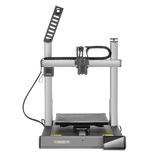The Comgrow T300 is a large-format, high-speed 3D printer designed for makers, hobbyists, creators, and prosumers who require substantial build volume without incurring significant costs.
With a considerable print area of approximately 300 × 300 × 350 mm (≈ 11.8 × 11.8 × 13.8 in), a primarily rugged all-metal frame, and modern features like a hardened all-metal hotend (which quickly reaches 300 °C) and a dual-gear direct drive extruder, it’s built to handle more demanding materials—from PLA to carbon-fiber composites.
It’s also powered by a 64-bit mainboard running Klipper firmware, which adds an 81-point automatic leveling system. The printer supports good print speeds (advertised up to ~ 600 mm/s) with stable mechanics to reduce vibration and wobble. These specs put the T300 in the higher tier among value large-size machines.
Comgrow T300 3D Printer: High-speed CoreXY with 300×300×350 mm build volume, Klipper firmware, dual-gear direct drive, and 300 °C all-metal hotend. Perfect for large, fast, and precise prints.
Related internal pages:
- t500-3d-printer/
- artillery-sidewinder-x3-plus-review/
- tronxy-veho-1000-20-3d-printer/
- tronxy-veho-800-pro-3d-printer/
- sovol-sv01-pro-3d-printer-review/
Specs & Mechanicals
Build Volume, Frame & Mechanical Rigidity
- Build Volume: 300 × 300 × 350 mm (X × Y × Z)
- Rails / Motion System: According to Sovol’s descriptions, the T300 uses “industrial grade linear rails” for motion, which suggests a shift away from smooth rods in favor of higher precision and stiffness.
- The robust metal structure is intended to help maintain print accuracy, especially at higher speeds or with heavier moves (large prints).
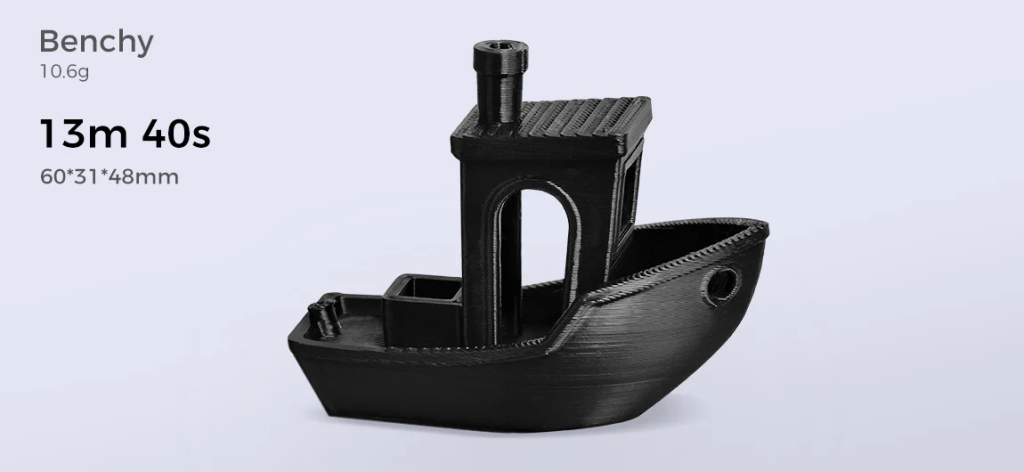

Hotend & Extruder
- Hotend Type & Max Temperature: The T300 supports nozzle temperatures up to 300 °C
- Extruder / Drive Mechanism: Dual-gear direct drive extruder with a 6.5:1 gear ratio. This higher gearing ratio aids with filament control, especially for flexible or composite filaments.
- Flow Rate / Throughput: The specs indicate the extruder can reach a flow rate of ~ 30 mm³/s
- Due to its all-metal design and hardened elements, the hotend is better suited to handle more demanding and abrasive materials (e.g., carbon-fiber composites) compared to a basic PTFE-lined hotend.
- Build Volume:300*300*350mm³
- Max Printing Speed:600mm/s
- All-metal Frame Body
- Double-Sided PEI Plate
- Operate Klipper on a 4.3″ Touchscreen
- 81-point Auto Leveling
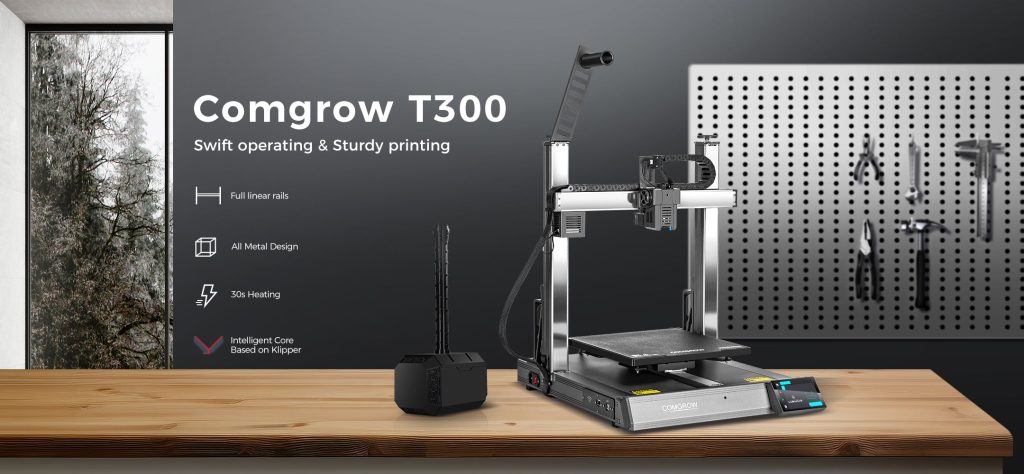
Intelligent Core Based on Klipper
The T300 optimizes a 64-bit microcomputer.
With Klipper, it not only significantly improves computational speed but also greatly enhances printing speed and quality through pressure advance and input shaping.
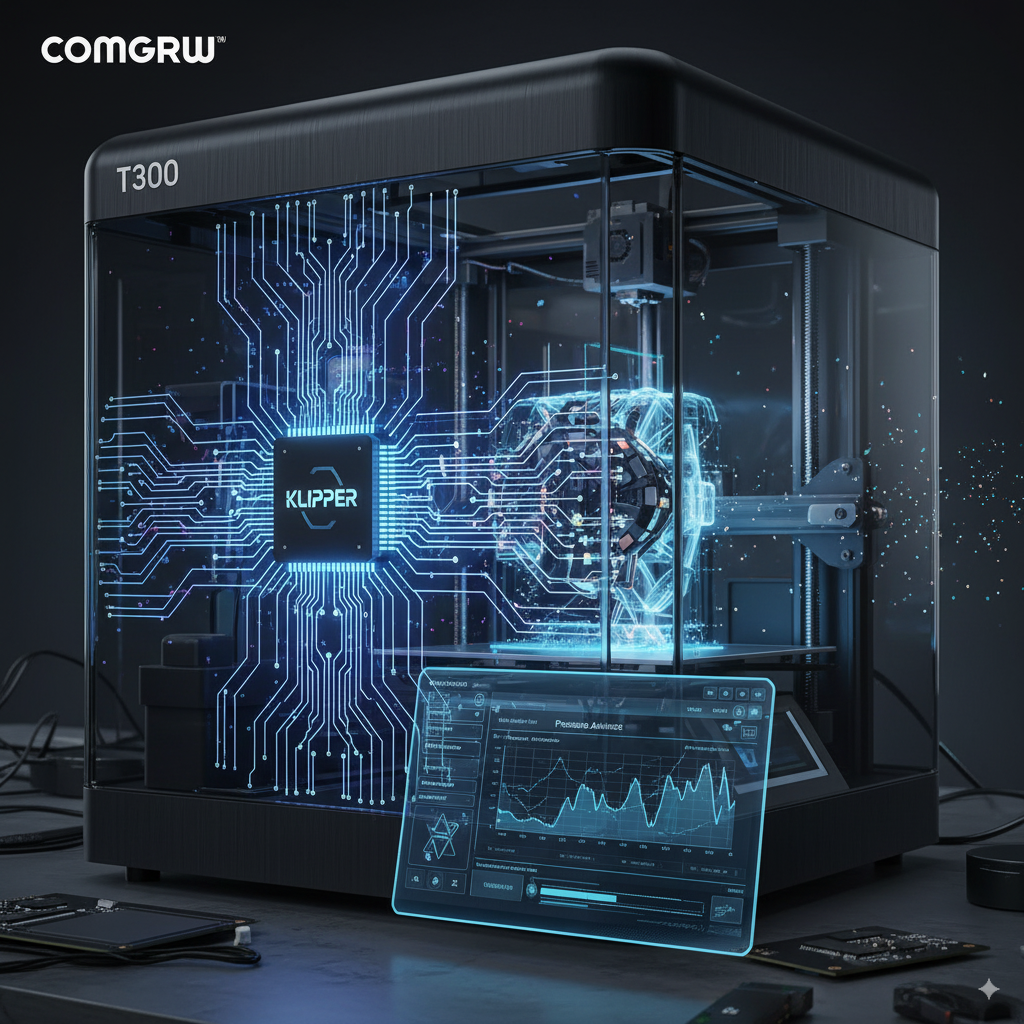
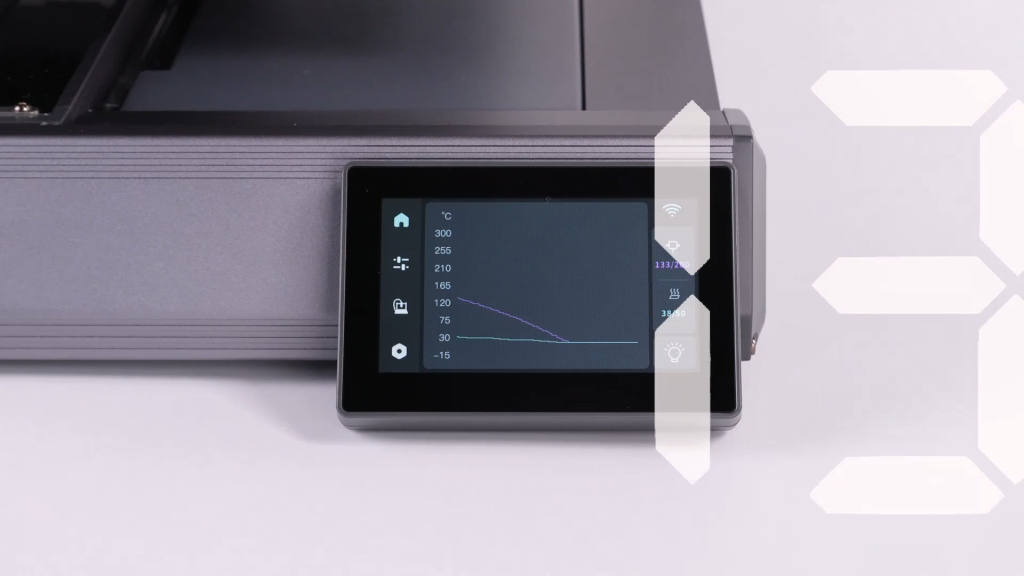
30s Heating
Long heating times are a thing of the past; with the T300, there’s less waiting and more printing fun.
4.3′ Touch Screen
The T300 features a 4.3-inch high-refresh-rate touchscreen with a resolution of 480×272 and an 85-degree viewing angle. It features a simple and user-friendly UI that makes operation convenient and provides a smooth visual experience.
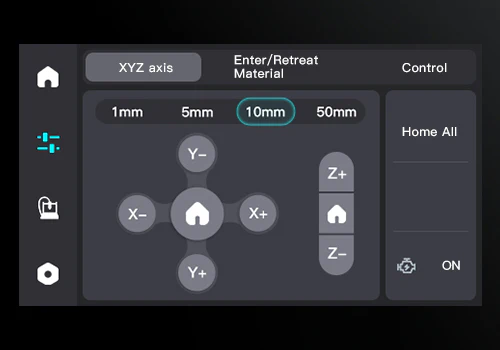
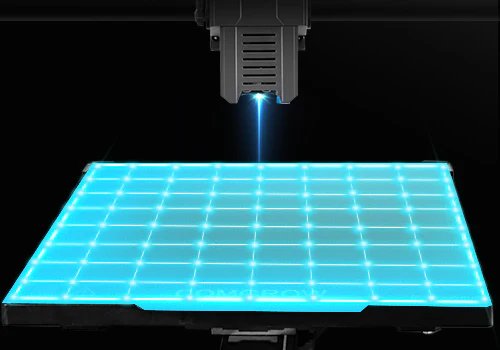
81-point Auto Leveling
Auto-leveling ensures the flatness of the heated bed, allowing for a perfect first layer without effort. The build plate automatically heats up before auto-leveling to match the actual printing flatness.
Perfectly Balanced Print Area
Maintaining the capability to print models encompassing 90% or more of its total build volume. It features a smaller and lighter heated bed compared to the T500, which reduces limitations on print speed and acceleration.

Value & Cost
Price at time of review (and shipping/imports)
- At many retailers, the Comgrow T300 is priced around US$269 (sale price), down from ~$449.
- Some sellers list it as $259 (with free shipping in certain regions)
- Depending on your location, import duties, local VAT, and shipping fees can significantly add to the landed cost. For example, 3DJake lists additional delivery costs (for U.S. shipments) starting at approximately €28.86.
- In some “premium” channels or local resellers, the price may still hover closer to $400–$450, depending on supply and demand.

Cost of ownership Filament:
Standard 1.75 mm filaments (such as PLA, PETG, and ABS) are comparable in cost to those used by other printers. More exotic or composite filaments (such as carbon fiber and nylon-CF) cost more, but that’s not unique to the T300. Electricity: Since the T300 is capable of fast printing and aggressive movements, it may draw more power during high thermal output (bed and hotend). However, the average power draw during typical print jobs should align with that of other large-format printers.
Replacement parts:
• Nozzles / hotend components (wear parts)
• PEI build plates (double-sided)
• Fans, belts, linear rail blocks
• Sensors, wiring harnesses
• Occasional board or stepper replacements under heavy use
FAQs
What is the most silent 3D printer?
Typically, the quietest 3D printers utilize high-quality stepper drivers (such as Trinamic or TMC drivers), effective damping, enclosed frames, and low-noise fans. For example, the Flashforge Adventurer 5M Pro is reported to run under ~ 50 dB
How many MB is good for printing?
If by “MB” you mean memory (firmware buffer or G-code buffer), most printers with ~ 16-32 MB of flash / RAM are adequate for typical print jobs. More memory is helpful for large G-code files, high-detail slicing, or advanced features.
What’s Included in Your Packages?
Layer height is the thickness of each layer of plastic (or resin) deposited during printing. A smaller layer height (e.g., 0.1 mm) yields finer detail but increases print time; a larger layer height (e.g., 0.3-0.4 mm) builds faster but reduces surface smoothness.
Why is printing so slow?
Common reasons include high layer height resolution, low speed settings, long travel moves or multiple retractions, inadequate cooling (which requires slower speeds to avoid overheating), and sometimes conservative acceleration/jerk settings.
What is the strongest 3D print pattern?
One of the strongest infill patterns is Gyroid, as it provides good support in all directions (isotropic support) and balances strength against filament usage well.
What is SLA in 3D printing?
SLA stands for Stereolithography. It uses a light source (laser or UV) to cure liquid resin, layer by layer, to form the object. It generally yields higher detail, smoother surfaces, but requires resin handling, supports, and post-processing.
What are the three types of 3D printing?
Broadly, three common types are:
- FFF / FDM (Fused Filament Fabrication / Deposition) — melting filament and extruding.
- SLA / DLP / Resin-based — curing resin with light.
- SLS / Powder-based — using lasers or binders to fuse or join powder particles.
Competitor angle: Understanding which type of competitor a competitor uses (or offers) helps you compare which use cases suit them best (detail, strength, cost, size, etc.).
What causes stringing in a 3D print?
Stringing (thin wispy threads between parts) is typically caused by: filament oozing during travel moves (hotend stays hot), insufficient retraction distance or speed, too high nozzle temperature, or slow cooling.
How many wall loops are in 3D printing?
Wall loops, also called perimeters or shells, form the print’s outer walls. Moreover, the number of loops can vary based on your needs. Typically, prints use two to three wall loops. This number depends on the desired strength and wall thickness. Adding more loops increases the print’s outer durability and resistance. However, it also extends print time and uses more material. Therefore, finding the right balance is essential for optimal results
What is infill in 3D printing?
Infill is the internal fill pattern inside a 3D print (between the outer walls). It provides internal support, strength, and rigidity without making the object solid. Users vary in infill density (e.g., 10-80%) and pattern (grid, gyroid, honeycomb, etc.) depending on the balance of strength, weight, and filament usage.





